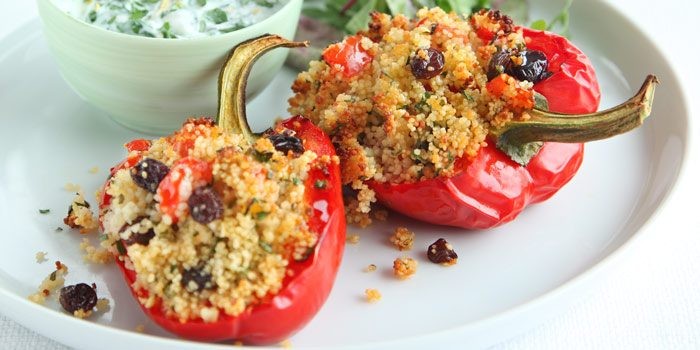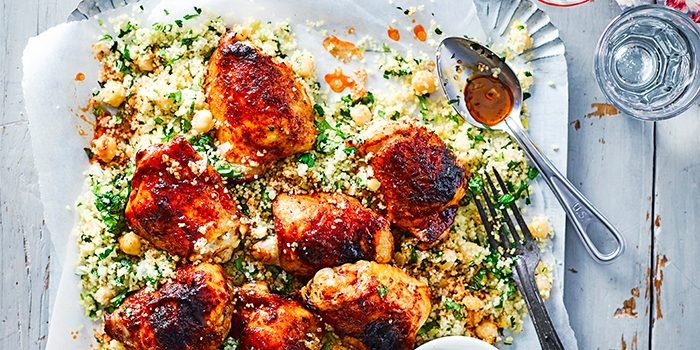Couscous Food Value is often underestimated, but this versatile grain offers a wealth of nutritional benefits. FOODS.EDU.VN delves into the complete profile of couscous, exploring its many uses, nutritional advantages, and providing tasty ways to incorporate it into your diet. We’ll uncover why couscous is more than just a quick side dish; it’s a healthy and adaptable ingredient. Discover the nutritional advantages, recipe ideas, and expert advice you need to make couscous a staple in your healthy eating plan.
1. Couscous: More Than Just a Grain
Couscous, frequently mistaken for a grain, is actually made of small steamed granules of semolina, or wheat middlings. In North African cuisines, especially those of Morocco, Algeria, Tunisia, and Libya, it is a staple. Couscous has gained popularity all over the world because to its ease of preparation and flexibility. But beyond its convenience, couscous boasts a good nutritional profile, making it a worthwhile addition to a balanced diet.
1.1. A Brief History of Couscous
The origins of couscous can be traced back centuries, with evidence suggesting its presence in North Africa as early as the 11th century. Traditionally, making couscous was a labor-intensive process, involving hand-rolling semolina and steaming it over a stew. Today, while the traditional methods still exist, most couscous is produced industrially, making it readily available and quick to prepare.
1.2. Types of Couscous Available
When you’re navigating the grocery store, you’ll find that couscous isn’t just one-size-fits-all. Here are the main types you’ll encounter:
- Moroccan Couscous: Also known as fine or instant couscous, this is the smallest variety and the most common type found in supermarkets. It cooks in just minutes with boiling water or broth.
- Israeli Couscous (Pearl Couscous): These are larger, rounder granules, about the size of small pearls. It has a chewier texture and a slightly nutty flavor. Israeli couscous is often toasted before cooking.
- Lebanese Couscous (Moghrabieh): This is the largest type of couscous, with granules about the size of peas. It requires a longer cooking time and has a distinct, hearty texture.
- Whole Wheat Couscous: This variety is made from whole wheat flour, offering a higher fiber content and a slightly nutty flavor compared to regular couscous.
1.3. Simple Preparation Methods
One of the reasons couscous is so beloved is its ease of preparation. Here’s the most common method:
- Boil Liquid: Bring water or broth to a boil (usually a 1:1 ratio of couscous to liquid).
- Add Couscous: Remove from heat and stir in the couscous.
- Cover and Wait: Cover the pot and let it stand for 5-15 minutes, until the liquid is absorbed.
- Fluff: Fluff with a fork before serving.
For a more flavorful couscous, use broth instead of water, or add a drizzle of olive oil and a pinch of salt before cooking.
2. Unveiling the Nutritional Value of Couscous
Understanding the couscous food value is key to appreciating its role in a healthy diet. While often considered a simple carbohydrate, couscous offers a range of essential nutrients.
2.1. Detailed Nutritional Breakdown
Let’s take a closer look at the nutritional content of an 80g (cooked weight) serving of couscous:
| Nutrient | Amount |
|---|---|
| Calories | 142 Kcal / 607 KJ |
| Protein | 5.8g |
| Fat | 0.8g |
| Carbohydrate | 30.0g |
| Fiber | 1.8g |
| Potassium | 123mg |
| Selenium | 2.4mcg |
| Phosphorus | 103mg |
This table highlights the key nutrients found in couscous, demonstrating its contribution to a balanced diet.
2.2. The Power of Selenium
Couscous is a good source of selenium, an essential mineral with numerous health benefits. Selenium acts as an antioxidant, protecting cells from damage caused by free radicals. It also plays a crucial role in thyroid function, supporting the production of thyroid hormones, as cited in this National Institutes of Health (NIH) Fact Sheet.
2.3. Plant-Based Protein Source
While not a complete protein (meaning it doesn’t contain all nine essential amino acids in sufficient amounts), couscous provides a decent amount of plant-based protein. Protein is vital for building and repairing tissues, as well as for producing enzymes and hormones, as detailed in this Harvard T.H. Chan School of Public Health article.
2.4. Fiber Content and Digestive Health
Couscous contains fiber, which is important for digestive health. Fiber adds bulk to the diet, promoting regular bowel movements and preventing constipation. Whole wheat couscous, in particular, is a good source of fiber. According to a study published in the “American Journal of Clinical Nutrition,” diets high in fiber are associated with a lower risk of colon cancer.
2.5. Vitamins and Minerals
In addition to selenium and phosphorus, couscous contains other important vitamins and minerals, such as B vitamins, which are essential for energy production and nerve function. It also provides small amounts of iron, magnesium, and zinc.
3. Health Benefits of Couscous: A Deeper Dive
The couscous food value translates into a range of potential health benefits. Let’s explore some of the key advantages of including couscous in your diet.
3.1. Boosting the Immune System
The selenium content in couscous plays a significant role in supporting the immune system. Selenium helps to enhance immune responses and protect against infections. According to research published in “The Lancet,” adequate selenium intake is associated with improved immune function.
3.2. Supporting Thyroid Function
Selenium is essential for the proper functioning of the thyroid gland. It helps in the production of thyroid hormones, which regulate metabolism, growth, and development. A deficiency in selenium can lead to thyroid disorders, as explained in this Mayo Clinic article.
3.3. Promoting Heart Health
The fiber and selenium in couscous contribute to heart health. Fiber helps to lower cholesterol levels, while selenium acts as an antioxidant, protecting against oxidative stress and inflammation, both of which are risk factors for heart disease. A study in the “American Journal of Clinical Nutrition” found that higher intakes of selenium were associated with a reduced risk of coronary heart disease.
3.4. Enhancing Digestive Health
The fiber in couscous promotes healthy digestion by adding bulk to the stool and preventing constipation. Fiber also supports the growth of beneficial bacteria in the gut, which can improve overall gut health. According to a review in the “World Journal of Gastroenterology,” a diet rich in fiber can reduce the risk of digestive disorders.
3.5. Managing Blood Sugar Levels
Whole wheat couscous, with its higher fiber content, can help to regulate blood sugar levels. Fiber slows down the absorption of sugar into the bloodstream, preventing spikes and crashes in blood sugar. This can be particularly beneficial for people with diabetes or insulin resistance. A study in the “Journal of the American Medical Association” found that a high-fiber diet can improve blood sugar control in people with type 2 diabetes.
4. Couscous vs. Other Grains: A Nutritional Comparison
To truly appreciate the couscous food value, it’s helpful to compare it to other common grains.
4.1. Couscous vs. White Rice
Couscous offers several advantages over white rice. It generally contains more protein, fiber, and a wider range of vitamins and minerals.
| Nutrient | Couscous (Cooked, 1 cup) | White Rice (Cooked, 1 cup) |
|---|---|---|
| Calories | 176 | 205 |
| Protein | 6g | 4g |
| Fiber | 2g | 1g |
| Selenium | 63% DV | 10% DV |
As you can see, couscous provides a significant boost in selenium compared to white rice.
4.2. Couscous vs. Quinoa
Quinoa is often hailed as a superfood due to its complete protein profile and high nutrient content. While quinoa is indeed a nutritional powerhouse, couscous still holds its own. Quinoa is richer in protein and some micronutrients, but couscous offers a similar amount of fiber and is often more affordable.
| Nutrient | Couscous (Cooked, 1 cup) | Quinoa (Cooked, 1 cup) |
|---|---|---|
| Calories | 176 | 222 |
| Protein | 6g | 8g |
| Fiber | 2g | 5g |
| Iron | 1% DV | 15% DV |
4.3. Couscous vs. Brown Rice
Brown rice is a whole grain that is rich in fiber and nutrients. Compared to couscous, brown rice generally offers more fiber and magnesium. However, couscous cooks much faster and has a milder flavor, making it a more convenient option for some.
| Nutrient | Couscous (Cooked, 1 cup) | Brown Rice (Cooked, 1 cup) |
|---|---|---|
| Calories | 176 | 216 |
| Fiber | 2g | 4g |
| Magnesium | 2% DV | 11% DV |
5. Incorporating Couscous into Your Diet: Delicious and Nutritious Ideas
Now that you know about the couscous food value, let’s explore some tasty ways to include it in your meals.
5.1. Couscous as a Side Dish
Couscous makes an excellent side dish for a variety of meals. Simply cook it according to the package directions and fluff with a fork. You can add flavor by using broth instead of water, or by stirring in herbs, spices, or a drizzle of olive oil.
- Herbed Couscous: Mix cooked couscous with fresh herbs like parsley, mint, and cilantro.
- Spiced Couscous: Add spices like cumin, turmeric, and coriander to cooked couscous.
- Lemon Couscous: Stir in lemon zest and juice to cooked couscous for a bright, citrusy flavor.
5.2. Couscous in Salads
Couscous is a great addition to salads, adding texture and substance. It pairs well with a variety of vegetables, fruits, and proteins.
- Mediterranean Couscous Salad: Combine cooked couscous with chopped cucumber, tomatoes, red onion, olives, and feta cheese. Dress with a lemon vinaigrette.
- Cranberry Almond Couscous Salad: Mix cooked couscous with dried cranberries, slivered almonds, and chopped celery. Dress with a light vinaigrette.
- Grilled Vegetable Couscous Salad: Grill vegetables like zucchini, bell peppers, and eggplant. Chop and mix with cooked couscous. Dress with a balsamic vinaigrette.
5.3. Couscous in Main Courses
Couscous can be used as a base for main courses, providing a hearty and nutritious foundation.
- Couscous with Roasted Vegetables: Roast vegetables like carrots, sweet potatoes, and Brussels sprouts. Serve over cooked couscous with a drizzle of olive oil and a sprinkle of herbs.
- Couscous with Chickpeas and Spinach: Sauté spinach with garlic and chickpeas. Serve over cooked couscous with a dollop of yogurt.
- Couscous Stuffed Peppers: Halve bell peppers and fill with a mixture of cooked couscous, vegetables, herbs, and spices. Bake until the peppers are tender.
5.4. Couscous in Soups and Stews
Couscous can be added to soups and stews to thicken them and add texture.
- Vegetable Couscous Soup: Add cooked couscous to a vegetable soup for added heartiness.
- Chicken Couscous Stew: Stir cooked couscous into a chicken stew for a filling and nutritious meal.
5.5. Creative Couscous Recipes
Here are a few more creative ways to enjoy couscous:
- Couscous Breakfast Bowl: Top cooked couscous with fruit, nuts, and yogurt for a healthy breakfast.
- Couscous Cakes: Mix cooked couscous with vegetables, herbs, and an egg. Form into patties and pan-fry until golden brown.
- Couscous Dessert: Sweeten cooked couscous with honey and cinnamon. Top with fruit and nuts for a simple dessert.
Image alt text: Colorful gremolata couscous stuffed red bell peppers plated with fresh herbs.
6. Couscous: Considerations and Potential Drawbacks
While the couscous food value is undeniable, there are a few considerations to keep in mind.
6.1. Gluten Content
Couscous is made from semolina, a type of wheat. Therefore, it contains gluten and is not suitable for people with celiac disease or gluten intolerance. For those with gluten sensitivities, there are gluten-free alternatives like quinoa, rice, or millet.
6.2. Glycemic Index
Couscous has a moderate glycemic index (GI), meaning it can cause a moderate rise in blood sugar levels. People with diabetes or insulin resistance should consume couscous in moderation and pair it with protein and healthy fats to help stabilize blood sugar levels. Whole wheat couscous has a lower GI than regular couscous due to its higher fiber content.
6.3. Processing
Most commercially available couscous is pre-steamed and dried, which can result in some nutrient loss. Choosing whole wheat couscous can help to minimize this loss, as it retains more of the bran and germ of the wheat kernel.
6.4. Portion Control
While couscous is a healthy food, it’s important to practice portion control. An 80-100g portion of cooked couscous is generally sufficient for a serving. Couscous expands significantly when cooked, so be mindful of the amount you prepare.
7. Expert Opinions on Couscous Food Value
Nutritionists and dietitians generally agree that couscous can be a healthy addition to a balanced diet.
- Kerry Torrens, Registered Dietitian: “Couscous is an easy-to-prepare grain that offers a more nutritious alternative to white rice and can help support fiber intake. It offers a convenient source of carbohydrate for those who can tolerate gluten.”
- Nicola Shubrook, Nutritional Therapist: “Couscous is a useful source of a number of vitamins and minerals, including immune-supportive selenium. It’s a useful inclusion in a plant-focused diet.”
- The Mayo Clinic: “Whole grains, like couscous, are a good source of fiber, which can help lower cholesterol levels and reduce the risk of heart disease.”
8. Couscous Around the World: Culinary Traditions
Couscous is a staple in many cuisines around the world, particularly in North Africa and the Middle East.
8.1. North African Cuisine
In North Africa, couscous is often served with a flavorful stew made with meat, vegetables, and spices. The stew is typically poured over a mound of couscous, and the dish is eaten with a spoon or fork.
- Moroccan Couscous: Often features lamb or chicken, vegetables like carrots, zucchini, and turnips, and spices like ginger, cinnamon, and saffron.
- Algerian Couscous: May include tomatoes, peppers, and harissa paste for a spicy kick.
- Tunisian Couscous: Often incorporates seafood like fish or shrimp, as well as vegetables like potatoes and chickpeas.
8.2. Middle Eastern Cuisine
In the Middle East, couscous is often used in salads and side dishes. It may be mixed with herbs, vegetables, and spices, and served as part of a mezze platter.
- Lebanese Tabbouleh: A refreshing salad made with couscous (or bulgur), parsley, mint, tomatoes, and lemon juice.
- Israeli Couscous Salad: Combines pearl couscous with roasted vegetables, herbs, and a lemon vinaigrette.
8.3. Global Adaptations
Couscous has been adapted to suit a variety of global cuisines. It can be found in dishes ranging from Italian-inspired salads to Asian-fusion stir-fries.
- Italian Couscous Salad: Mixes couscous with pesto, mozzarella, and sun-dried tomatoes.
- Asian Couscous Stir-Fry: Combines couscous with stir-fried vegetables, soy sauce, and ginger.
Image alt text: A vibrant plate of Harissa sticky chicken served with fluffy couscous and a side of greens.
9. The Future of Couscous: Trends and Innovations
The popularity of couscous is likely to continue to grow as more people discover its versatility and nutritional benefits.
9.1. Gluten-Free Couscous Alternatives
As the demand for gluten-free options increases, manufacturers are developing couscous alternatives made from gluten-free grains like quinoa, rice, and corn. These alternatives offer a similar texture and flavor to traditional couscous, while catering to those with gluten sensitivities.
9.2. Enhanced Nutritional Profiles
Researchers are exploring ways to enhance the nutritional profile of couscous by fortifying it with vitamins, minerals, and protein. This could make couscous an even more valuable source of essential nutrients.
9.3. Sustainable Production Methods
As consumers become more aware of the environmental impact of food production, there is a growing demand for sustainable couscous production methods. This includes reducing water usage, minimizing pesticide use, and promoting fair labor practices.
10. Couscous Food Value: A Summary and Call to Action
Couscous is a versatile and nutritious grain that offers a range of health benefits. It’s a good source of selenium, plant-based protein, and fiber, and it can be easily incorporated into a variety of dishes. While it’s important to be mindful of its gluten content and glycemic index, couscous can be a valuable addition to a balanced diet for most people.
The couscous food value is clear: it’s a healthy, convenient, and delicious grain that can enhance your meals and support your well-being.
Are you looking for reliable and easy-to-follow recipes? Do you want to deepen your understanding of various ingredients and culinary techniques?
Visit FOODS.EDU.VN at 1946 Campus Dr, Hyde Park, NY 12538, United States or contact us via Whatsapp at +1 845-452-9600 to unlock a world of culinary knowledge. Our website offers detailed recipes, expert insights, and practical tips to help you master the art of cooking and make informed choices about your diet.
Frequently Asked Questions (FAQ) About Couscous Food Value
1. What exactly is couscous?
Couscous is a pasta made from semolina wheat, formed into small granules.
2. Is couscous healthy?
Yes, couscous can be a part of a healthy diet, offering fiber, selenium, and plant-based protein.
3. Is couscous gluten-free?
No, traditional couscous is made from wheat and contains gluten.
4. What are the health benefits of couscous?
Couscous supports the immune system, thyroid function, heart health, and digestive health.
5. How is couscous prepared?
Couscous is prepared by pouring boiling water or broth over the granules and letting it sit until the liquid is absorbed.
6. What is the nutritional profile of couscous?
An 80g serving of cooked couscous provides calories, protein, carbohydrates, fiber, and essential minerals like selenium and phosphorus.
7. Can couscous help manage blood sugar levels?
Whole wheat couscous can help regulate blood sugar levels due to its higher fiber content.
8. What are some creative ways to include couscous in my diet?
Couscous can be used in salads, as a side dish, in main courses, or even as a breakfast bowl.
9. What are the different types of couscous available?
Moroccan, Israeli (pearl), and Lebanese couscous are the main types.
10. Where can I find more information about couscous and healthy recipes?
Visit foods.edu.vn for detailed information, recipes, and expert tips on incorporating couscous into your diet.


